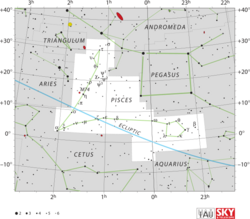Astronomy:Psi3 Piscium
| Observation data Equinox J2000.0]] (ICRS) | |
|---|---|
| Constellation | Pisces |
| Right ascension | 01h 09m 49.20099s[1] |
| Declination | +19° 39′ 30.2694″[1] |
| Apparent magnitude (V) | 5.562[2] |
| Characteristics | |
| Spectral type | F9 IIIa[3] or G0 IV[4] |
| B−V color index | −0.70[2] |
| Astrometry | |
| Radial velocity (Rv) | −6.6±2.1[5] km/s |
| Proper motion (μ) | RA: −6.064[1] mas/yr Dec.: +8.887[1] mas/yr |
| Parallax (π) | 7.5011 ± 0.1014[1] mas |
| Distance | 435 ± 6 ly (133 ± 2 pc) |
| Absolute magnitude (MV) | +3.38[6] |
| Details | |
| Mass | 2.8[7] M☉ |
| Radius | 10.29+1.20 −0.20[1] R☉ |
| Luminosity | 95.5±1.6[1] L☉ |
| Surface gravity (log g) | 4.16±0.17[8] cgs |
| Temperature | 6,554+143 −85[8] K |
| Metallicity [Fe/H] | +0.88±0.21[8] dex |
| Rotation | 9 d[7] |
| Rotational velocity (v sin i) | 87.7±4.4[6] km/s |
| Other designations | |
| Database references | |
| SIMBAD | data |
Psi3 Piscium, which is Latinized from ψ3 Piscium, is a solitary,[10] yellow-hued star in the zodiac constellation of Pisces. It is faintly visible to the naked eye, having an apparent visual magnitude of 5.562.[2] Based upon an annual parallax shift of 7.5 mas as seen from Earth,[1] it is located about 435 light years from the Sun. At that distance, the visual magnitude is diminished by an extinction factor of 0.33 due to interstellar dust.[4] The star is drifting closer to the Sun with a radial velocity of −7 km/s.[5]
This F-type giant is a candidate horizontal branch[8] star with a stellar classification of F9 IIIa.[3] It is an X-ray source with a luminosity of (0.82±0.13)×1030 erg s−1 in the 0.3−10 keV band.[7] The projected rotational velocity is 87.7±4.4 km/s and it has an effective temperature of 6,273.[6] It has 2.8[7] times the mass of the Sun and 10.3[1] times the Sun's radius. The star is radiating 95.5[1] times the luminosity of the Sun from its enlarged photosphere at an effective temperature of 6,554 K.[8]
References
- ↑ 1.0 1.1 1.2 1.3 1.4 1.5 1.6 1.7 1.8 1.9 Brown, A. G. A. (August 2018). "Gaia Data Release 2: Summary of the contents and survey properties". Astronomy & Astrophysics 616: A1. doi:10.1051/0004-6361/201833051. Bibcode: 2018A&A...616A...1G. Gaia DR2 record for this source at VizieR.
- ↑ 2.0 2.1 2.2 Høg, E. et al. (March 2000), "The Tycho-2 catalogue of the 2.5 million brightest stars", Astronomy and Astrophysics 355: L27–L30, doi:10.1888/0333750888/2862, Bibcode: 2000A&A...355L..27H.
- ↑ 3.0 3.1 Keenan, Philip C.; McNeil, Raymond C. (1989), "The Perkins catalog of revised MK types for the cooler stars", Astrophysical Journal Supplement Series 71: 245, doi:10.1086/191373, Bibcode: 1989ApJS...71..245K.
- ↑ 4.0 4.1 van Belle, G. T. et al. (May 2008), "The Palomar Testbed Interferometer Calibrator Catalog", The Astrophysical Journal Supplement Series 176 (1): 276–292, doi:10.1086/526548, Bibcode: 2008ApJS..176..276V.
- ↑ 5.0 5.1 de Bruijne, J. H. J.; Eilers, A.-C. (October 2012), "Radial velocities for the HIPPARCOS-Gaia Hundred-Thousand-Proper-Motion project", Astronomy & Astrophysics 546: 14, doi:10.1051/0004-6361/201219219, A61, Bibcode: 2012A&A...546A..61D.
- ↑ 6.0 6.1 6.2 Reiners, Ansgar (January 2006), "Rotation- and temperature-dependence of stellar latitudinal differential rotation", Astronomy and Astrophysics 446 (1): 267–277, doi:10.1051/0004-6361:20053911, Bibcode: 2006A&A...446..267R
- ↑ 7.0 7.1 7.2 7.3 Gondoin, P. (December 2005), "The relation between X-ray activity and rotation in intermediate-mass G giants", Astronomy and Astrophysics 444 (2): 531–538, doi:10.1051/0004-6361:20053567, Bibcode: 2005A&A...444..531G.
- ↑ 8.0 8.1 8.2 8.3 8.4 Behr, Bradford B. (November 2003), "Rotation Velocities of Red and Blue Field Horizontal-Branch Stars", The Astrophysical Journal Supplement Series 149 (1): 101–121, doi:10.1086/378352, Bibcode: 2003ApJS..149..101B.
- ↑ "psi03 Psc". SIMBAD. Centre de données astronomiques de Strasbourg. http://simbad.u-strasbg.fr/simbad/sim-basic?Ident=psi03+Psc.
- ↑ Eggleton, P. P.; Tokovinin, A. A. (September 2008), "A catalogue of multiplicity among bright stellar systems", Monthly Notices of the Royal Astronomical Society 389 (2): 869–879, doi:10.1111/j.1365-2966.2008.13596.x, Bibcode: 2008MNRAS.389..869E.
 |


